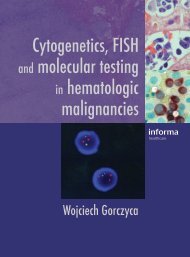Color Atlas of Hematology - Practical Microscopic and Clinical ...
Color Atlas of Hematology - Practical Microscopic and Clinical ...
Color Atlas of Hematology - Practical Microscopic and Clinical ...
- No tags were found...
You also want an ePaper? Increase the reach of your titles
YUMPU automatically turns print PDFs into web optimized ePapers that Google loves.
158Erythrocyte <strong>and</strong> Thrombocyte AbnormalitiesHematological Diagnosis <strong>of</strong> MalariaVarious parasites may be found in the blood stream, e.g., trypanosomes<strong>and</strong> filariae. Among the parasitic diseases, probably only malaria is <strong>of</strong>practical diagnostic relevance in the northern hemisphere, while at thesame time malarial involvement <strong>of</strong> erythrocytes may confuse the interpretation<strong>of</strong> erythrocyte morphology. For these reasons, a knowledge <strong>of</strong>the principal different morphological forms <strong>of</strong> malarial plasmodia isadvisable.Recurrent fever <strong>and</strong> influenza-like symptoms after a stay in tropical regionssuggest malaria. The diagnosis may be confirmed from normalblood smears or thick smears; in the latter the erythrocytes have beenhemolyzed <strong>and</strong> the pathogens exposed. Depending on the stage in the lifecycle <strong>of</strong> the plasmodia, a variety <strong>of</strong> morphologically completely differentforms may be found in the erythrocytes, sometimes even next to eachother. The different types <strong>of</strong> pathogens show subtle specific differencesthat, once the referring physician suspects malaria, are best left to thespecialist in tropical medicine, who will determine which <strong>of</strong> the followingis the causative organism: Plasmodium vivax (tertian malaria), Plasmodiumfalciparum (falciparum or malignant tertian malaria) <strong>and</strong> Plasmodiummalariae (quartan malaria) (Table 27, Fig. 56). Most cases <strong>of</strong>malaria are caused by P. vivax (42%) <strong>and</strong> P. falciparum (43%).The key morphological characteristics in all forms <strong>of</strong> malaria can besummarized as the following basic forms: The first developmental stage <strong>of</strong>the pathogen, generally found in quite large erythrocytes, appears as smallring-shaped bodies with a central vacuole, called trophozoites (or thesignet-ring stage) (Fig. 57). The point-like center is usually most noticeable,as it is reminiscent <strong>of</strong> a Howell–Jolly body, <strong>and</strong> only a very carefulsearch for the delicate ring form will supply the diagnosis. Occasionally,there are several signet-ring entities in one erythrocyte. All invaded cellsmay show reddish stippling, known as malarial stippling or Schüffner’sdots. The pathogens keep dividing, progressively filling the vacuoles, <strong>and</strong>then develop into schizonts (Fig. 56), which soon fill the entire erythrocytewith an average <strong>of</strong> 10–15 nuclei. Some schizonts have brown-black pigmentinclusions. Finally the schizonts disintegrate, the erythrocyte ruptures,<strong>and</strong> the host runs a fever. The separate parts (merozoites) then start anew invasion <strong>of</strong> erythrocytes.In parallel with asexual reproduction, merozoites develop into gamonts,which always remain mononuclear <strong>and</strong> can completely fill theerythrocyte with their stippled cell bodies. The large, dark blue-stainedforms (macrogametes) are female cells (Fig. 57 d), the smaller, light bluestainedforms (microgametes) are male cells. Macrogametes usually predominate.They continue their development in the stomach <strong>of</strong> the infectedAnopheles mosquito.






